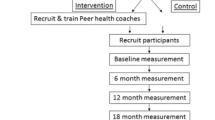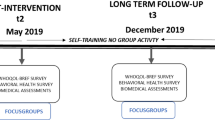Abstract
Objectives
The effectiveness of community level interventions depends to a great extent on adherence. Currently, information on factors related to adherence in older adults from developing countries is scarce. Our aim was to identify factors associated to adherence to a physical activity intervention in older adults from a post-transitional middle income country.
Design, setting and participants
Using a combination of quantitative and qualitative methods we studied 996 older Chilean subjects (65–67.9 years at baseline) with low to medium socioeconomic status from 10 health centers randomized to receive a physical activity intervention as part of the CENEX cluster trial (ISRCTN48153354).
Measurements
Using a multilevel regression model, the relationship between adherence (defined a priori as attendance at a minimum of 24 physical activity classes spread over at least 12 months) and individual, intervention-related and contextual factors was evaluated. We also conducted 40 semi-structured interviews with older adults (n=36) and instructors (n=4). Transcripts of the interviews were analyzed using content analysis to identify barriers and facilitators to adherence.
Results
Adherence to physical activity intervention was 42.6% (CI 95% 39.5 to 45.6). Depression, diabetes mellitus, percentage of impoverished households and rate of arrests for violent crimes in the neighborhood predicted less adherence (p<0.05) while being retired, participation in physical activity prior to the intervention, and green areas per habitant were positively associated with adherence (p<0.05). The qualitative interviews identified three primary barriers to adherence: current health problems, lack of time due to commitments for caring for family members, and being employed, and two primary facilitators to adherence: the health benefits attributed to the intervention and the opportunity the classes provided for social interaction with others.
Conclusion
In order to enhance effectiveness of community exercise interventions, strategies to improve participation should be targeted to older adults from deprived areas and those with psychological and medical conditions.
Similar content being viewed by others
Abbreviations
- PA:
-
physical activity
- RCT:
-
Randomized Controlled Trial
- PCHC:
-
Primary Care Health Center
- GDS-15:
-
Yesavage Geriatric Depression Scale, 15-question version
- COPD:
-
chronic obstructive pulmonary disease
- LSHTM:
-
London School of Hygiene & Tropical Medicine
- SD:
-
standard deviation
- OR:
-
odds ratio
- CI:
-
confidence interval
- OA:
-
older adults
- P:
-
physical education instructors
References
Nelson ME, Rejeski WJ, Blair SN, Duncan PW, Judge JO, King AC, Macera CA, Castaneda-Sceppa C (2007) Physical activity and public health in older adults: recommendation from the American College of Sports Medicine and the American Heart Association. Circulation 116:1094–1105
World Health Organisation (2007) Global Age Friendly Cities: A guide. Geneva
U.S. Department of Health and Human Services (2008) 2008 Physical Activity Guidelines for Americans.
Chodzko-Zajko WJ, Proctor DN, Fiatarone Singh MA, Minson CT, Nigg CR, Salem GJ, Skinner JS (2009) American College of Sports Medicine position stand. Exercise and physical activity for older adults. Med Sci Sports Exerc 41:1510–1530.
Robinson S, Cooper C, Aihie Sayer A (2012) Nutrition and sarcopenia: a review of the evidence and implications for preventive strategies. J Aging Res. doi:10.1155/2012/510801
Rhodes RE, Warburton DE, Murray H (2009) Characteristics of physical activity guidelines and their effect on adherence: a review of randomized trials. Sports Med 39:355–375.
Tellez A (2004) [Prevention and patient’s compliance. Two key factors to deal with non communicable chronic diseases]. Rev Med Chil 132:1453–1455
White JL, Ransdell LB, Vener J, Flohr JA (2005) Factors related to physical activity adherence in women: review and suggestions for future research. Women Health 41:123–148
Department of Health and Human Services, Centers for Disease Control and Prevention, (1996) Physical activity and health; A Report of the Surgeon General. Atlanta, GA
Praet SF, van Loon LJ (2009) Exercise therapy in type 2 diabetes. Acta Diabetol 46:263–278.
Martin K, Sinden A (2001) Who will stay and who will go? A review of older adults? adherence to randomized controlled trials of exercise. Journal of Aging and Physical Activity 9:91–114
Martin KA, Bowen DJ, Dunbar-Jacob J, Perri MG (2000) Who will adhere? Key issues in the study and prediction of adherence in randomized controlled trials. Control Clin Trials 21:195S–199S.
Schutzer KA, Graves BS (2004) Barriers and motivations to exercise in older adults. Prev Med 39:1056–1061.
Bauman A, Reis R, Sallis J, Wells J, Ruth L, Brian M (2012) Correlates of physical activity: why are some people physically active and others not? The Lancet 380:258–271
Albala C, Vio F, Kain J, Uauy R (2002) Nutrition transition in Chile: determinants and consequences. Public Health Nutr 5:123–128.
Dangour AD, Albala C, Aedo C, Elbourne D, Grundy E, Walker D, Uauy R (2007) A factorial-design cluster randomised controlled trial investigating the cost-effectiveness of a nutrition supplement and an exercise programme on pneumonia incidence, walking capacity and body mass index in older people living in Santiago, Chile: the CENEX study protocol. Nutr J 5:6–14
Dangour AD, Albala C, Allen E, Grundy E, Walker DG, Aedo C, Sanchez H, Fletcher O, Elbourne D, Uauy R (2011) Effect of a nutrition supplement and physical activity program on pneumonia and walking capacity in chilean older people: a factorial cluster randomized trial. PLoS Med 8:e1001023.
Dodd T (2008) Quantitative and qualitative research data and their relevance to policy and practice. Nurse Res 15:7–14
Quiroga P, Albala C, Klaasen G (2004) [Validation of a screening test for age associated cognitive impairment, in Chile]. Rev Med Chil 132:467–478
Sheikh J, Yesavage J, (1986) Geriatric Depression Scale (GDS): Recent evidence and development of a shorter version. Clinical Gerontology: A Guide to Assessment and Intervention. The Haworth Press, NY
WHO (2000) Obesity: preventing and managing the global epidemic. Report of a WHO Consultation. World Health Organization, Geneva
Governement of Chile, Ministry of Housin. Indicadores urbanos. http://www.minvu.cl/opensite_20070212170245.aspx Accessed 06 June 2008
Dishman RK, Sallis JF, Orenstein DR (1985) The determinants of physical activity and exercise. Public Health Rep 100:158–171
Wilbur J, Michaels Miller A, Chandler P, McDevitt J (2003) Determinants of physical activity and adherence to a 24-week home-based walking program in African American and Caucasian women. Res Nurs Health 26:213–224
Sherwood NE, Jeffery RW (2000) The behavioral determinants of exercise: implications for physical activity interventions. Annu Rev Nutr 20:21–44
Forkan R, Pumper B, Smyth N, Wirkkala H, Ciol MA, Shumway-Cook A (2006) Exercise adherence following physical therapy intervention in older adults with impaired balance. Phys Ther 86:401–410
Burton LC, Shapiro S, German PS (1999) Determinants of physical activity initiation and maintenance among community-dwelling older persons. Prev Med 29:422–430.
Moschny A, Platen P, Klaassen-Mielke R, Trampisch U, Hinrichs T (2011) Barriers to physical activity in older adults in Germany: a cross-sectional study. Int J Behav Nutr Phys Act 8:121.
Humpel N, Owen N, Leslie E (2002) Environmental factors associated with adults’ participation in physical activity: a review. Am J Prev Med 22:188–199
Kavanagh AM, Goller JL, King T, Jolley D, Crawford D, Turrell G (2005) Urban area disadvantage and physical activity: a multilevel study in Melbourne, Australia. J Epidemiol Community Health 59:934–940
Chen M, Feng HZ, Gupta D, Kelleher J, Dickerson KE, Wang J, Hunt D, Jou W, Gavrilova O, Jin JP, Weinstein LS (2009) G(s)alpha deficiency in skeletal muscle leads to reduced muscle mass, fiber-type switching, and glucose intolerance without insulin resistance or deficiency. Am J Physiol Cell Physiol 296:C930–940.
Annear MJ, Cushman G, Gidlow B (2009) Leisure time physical activity differences among older adults from diverse socioeconomic neighborhoods. Health Place 15:482–490.
Boyette LW, Sharon BF, Brandon LJ (1997) Exercise adherence for a strength training program in older adults. J Nutr Health Aging 1:93–97
Litt MD, Kleppinger A, Judge JO (2002) Initiation and maintenance of exercise behavior in older women: predictors from the social learning model. J Behav Med 25:83–97
Capomolla S, Ceresa M, Civardi A, Lupo A, Ventura A, Scabini M, Leonelli P, Salvaneschi G, Petocchi A, Pinna G, Ferrari M, Febo O, Caporotondi A, Guazzotti G, La Rovere MT, Gnemmi M, Maestri R, Cobelli F (2002) [Home exercise therapy in chronic congestive heart failure: observational study of factors affecting adherence to the program]. Ital Heart J Suppl 3:1098–1105
Author information
Authors and Affiliations
Corresponding author
Rights and permissions
About this article
Cite this article
Garmendia, M.L., Dangour, A.D., Albala, C. et al. Adherence to a physical activity intervention among older adults in a post-transitional middle income country: A quantitative and qualitative analysis. J Nutr Health Aging 17, 466–471 (2013). https://doi.org/10.1007/s12603-012-0417-1
Received:
Accepted:
Published:
Issue Date:
DOI: https://doi.org/10.1007/s12603-012-0417-1




